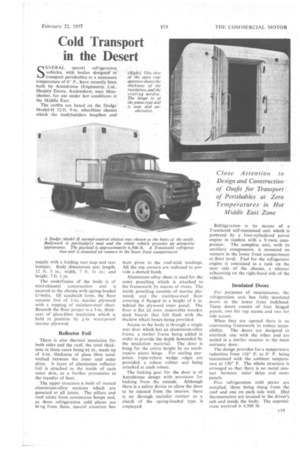Cold Transport in the Desert
Page 47

If you've noticed an error in this article please click here to report it so we can fix it.
SEVERAL special refrigeration vehicles, with bodies designed to . transport perishables at a minimum temperature of 0 F., have recently been built by Autodrome (Engineers), Ltd., Shepley Estate, Audenshaw, near Manchester, for use under hot conditions in the Middle East.
The outfits are based on the Dodge. Model-H 12-ft. 9-in. wheelbase chassis which the bodybuilders lengthen and supply with a folding rear. step and rear bumper. Body dimensions are: length, 12 ft. 3 in.; width, 7 ft. 11 in.; and height. 7 ft. 1 in.
The underframe of the body is of steel-channel construction and is secured to the chassis with spring-loaded U-bolts. Of sandwich form, the floor consists first of I-in, marine plywood with a topping of stainless-steel sheet. Beneath the floor proper is a 5-in, thickness of glass-fibre insulation which is held in position by 1-in. waterproof marine 'plywood.
Reflector Foil
There is also thermal insulation for both sides and the roof, the total thickness in these cases being 6+ in., made up of 6-in, thickness of glass fibre sandwiched between the inner and outer skins. A layer of aluminium reflector foil is attached to the inside of each outer skin, as a further preventive to the transfer of heat.
The upper structure is built of riveted aluminium-alloy sections which are gusseted at all joints. The pillars and roof sticks form continuous hoops and. as three refrigeration cold plates are ng from them, special attention has been given to the roof-stick loadings. All the top corners are radiused to provide a domed finish.
Aluminium-alloy sheet is used for the outer panelling which is attached to the framework by means of rivets. The inside panelling consists of marine plywood, and the stainless-steel floor covering ii flanged to a height of 6 in. behind the plywood inner panel. The floor is flat all over, removable wooden duck boards that fall flush with the shallow wheel boxes being provided.
Access to the body is through a single rear door which has an aluminium-alloy frame, a timber frame being added in order to provide the depth demanded by the insulation material. The door is hung for the entire height by an unobtrusive piano hinge. For sealing purposes, triple-rebate wedge edges arc provided, a robust rubber seal being attached at each rebate.
The locking gear for the door is of Autodrome design with provision for locking from the outside. Although there is a safety device to allow the door to be opened from the interior, there is no through metallic contact as a clutch of the spring-loaded type is employed. Refrigeration is by means of a Transicold self-contained unit which is powered by a four-cylindered petrol engine in tandem with a V-twin .compressor. The complete unit, with its ancillary components, is mounted on runners in the lower front compartment at, floor level. Fuel for the refrigerator engine is contained in a tank on the near side of the chassis, a silencer exhausting on the right-hand side of the vehicle.
Insulated Doors
For purposes of maintenance, the refrigeration unit has fully insulated doors in the lower front bulkhead. These doors consist of four hinged panels, two for top access and two fw side access.
When they are opened there is no intervening framework to reduce accessibility. The doors are designed to interlock one with the other and are sealed in a similar manner to the main entrance door.
The design provides for a temperature reduction from 110° F. to 0° F. being maintained with the ambient temperature at 130° F. The whole structure is arranged so that there is no metal contact between inner ' skins and outer panels.
Five refrigeration cold plates are installed, three being slung from the roof and one on each side wall. Dial thermometers are located in the driver's cab and inside the body. The approximate payload is 6,500 lb
























































































